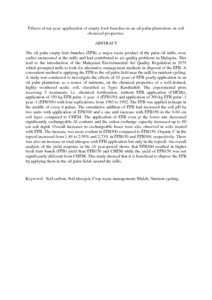Citation
Abu Bakar, Rosenani and Darus, Siti Zauyah and Kulaseharan, S. and Jamaluddin, N.
(2011)
Effects of ten year application of empty fruit bunches in an oil palm plantation on soil chemical properties.
Nutrient Cycling in Agroecosystems, 89 (3).
pp. 341-349.
ISSN 1385-1314
Abstract
The oil palm empty fruit bunches (EFB), a major waste product of the palm oil mills, were earlier incinerated at the mills and had contributed to air quality problems in Malaysia. This lead to the introduction of the Malaysian Environmental Air Quality Regulation in 1978 which prompted mills to look for alternative management methods in disposal of the EFB. A convenient method is applying the EFB to the oil palm field near the mill for nutrient cycling. A study was conducted to investigate the effects of 10 years of EFB yearly application in an oil palm plantation, as a source of nutrients, on the chemical properties of a well-drained, highly weathered acidic soil, classified as Typic Kandiudult. The experimental plots receiving 3 treatments, i.e. chemical fertilization, without EFB application (CHEM)), application of 150 kg EFB palm -1 year -1 (EFB150) and application of 300 kg EFB palm -1 year -1 (EFB300) with four replications, from 1983 to 1992. The EFB was applied in heaps in the middle of every 4 palms. The cumulative addition of EFB had increased the soil pH by two units with application of EFB300 and a one unit increase with EFB150 in the 0-60 cm soil layer, compared to CHEM. The application of EFB even at the lower rate decreased significantly exchangeable Al contents and the cation exchange capacity increased up to 60 cm soil depth. Overall increases in exchangeable bases were also observed in soils treated with EFB. The increase was more evident in EFB300 compared to EFB150. Organic C in the topsoil increased from 1.49 to 2.50% and 2.73% in EFB150 and EFB300, respectively. There was also an increase in total nitrogen with EFB application but only in the topsoil. An overall analysis of the yield response in the 10 year-period shows that EFB300 resulted in higher fresh fruit bunch (FFB) yield than EFB150 and CHEM while the yield of EFB150 was not significantly different from CHEM. This study showed that it is beneficial to dispose the EFB by applying them in the oil palm fields around the mills.
Download File
![[img]](http://psasir.upm.edu.my/23668/1.hassmallThumbnailVersion/Effects%20of%20ten%20year%20application%20of%20empty%20fruit%20bunches%20in%20an%20oil%20palm%20plantation%20on%20soil%20chemical%20properties.pdf)  Preview |
|
PDF (Abstract)
Effects of ten year application of empty fruit bunches in an oil palm plantation on soil chemical properties.pdf
Download (86kB)
| Preview
|
|
Additional Metadata
Actions (login required)
 |
View Item |

